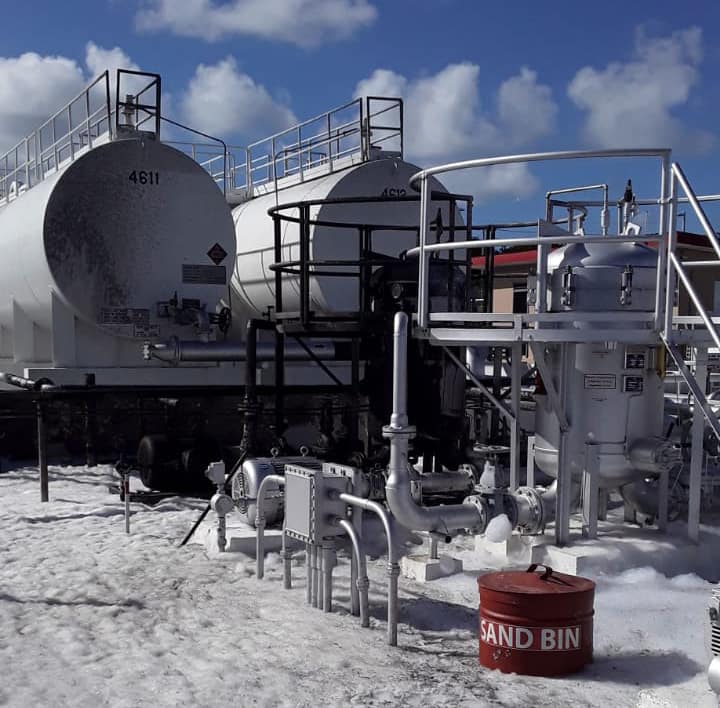
The LPG provider’s no. 2 pump, located near to the tarmac at the V.C. Bird International Airport, caught on fire today at around 1:20 pm possibly because of leakage at the pump.
Also, the fire left some damage to a filter vessel of the pump and also slight damage to the no. 3 pump which sits immediate beside it.
The firemen arrived on scene within 10 minutes and used foam to extinguish the blaze before the fire could spread to the main LPG storage tanks.
According to Fire Brigade Chief Elvis Weaver, the fire was caused due to possible leakage at the pump.
“These things are man-made, so there was probably some accident that took place. But I think that Rubis has all its safety measures in place. And, we do a lot of educational [activities] with them… a lot of drills etc.” Weaver explained.
He also shared that he does not believe the fire had anything to do with human error.
There were no injuries or casualties suffered as a result of the fire.
Advertise with the mоѕt vіѕіtеd nеwѕ ѕіtе іn Antigua!
We offer fully customizable and flexible digital marketing packages.
Contact us at [email protected]

















Notes From A Native Son Of he Rock! The Afrocentric method considers phenomena to be diverse, dynamic, and in motion and therefore it is necessary for a person to accurately note and record the location of phenomena even in the midst of fluctuations. This means that the investigator must know where he or she is standing in the process.” – Dr. Molefi Asante on The Theory of Social Change!
“The firemen arrived on scene within 10 minutes and used foam to extinguish the blaze before the fire could spread to the main LPG storage tanks.” ANR 08122019!
Many will say “All’s Well That Ends Well!” The ABAA and the ECCAA Authorities should view this result as a major test of Preparedness and Effectiveness! It should be Evaluated and Quality Improvements Implemented!
For a major International Airport that response time shows the ABAA CEO, Board and the Minister of Aviation that the Fire Department is faced with several challenges! “Everything can be explained to the people, on the single condition that you really want them to understand.” ― Frantz Fanon, The Wretched of the Earth!
The fire Department is located air-side and adjacent to the taxiway and ramps within the confines of the VCBIA! In a previous life these are the practices which were followed! The Airport Fire Department should be Guided by three basic components of fire department emergency response performance:
Availability—The degree to which the resources are ready and available to respond.
Capability—The abilities of deployed resources to manage an incident.
Operational Effectiveness—A product of availability and capability. It is the outcome achieved by the deployed resources or the ability to match resources deployed to the risks to which they are responding.
Here this mere voice in the wilderness will quote the International NFPA! How do fire departments accurately evaluate their response in these three areas? “NFPA 1710: Standard for the Organization and Deployment of Fire Suppression Operations, Emergency Medical Operations, and Special Operations to the Public by Career Fire Departments establishes criteria that provide a good place to start. Those criteria include:
Alarm Answering Time: 15 seconds for 95% of calls; 40 seconds for 99% of calls
Alarm Processing Time: 64 seconds for 90% of calls; 106 seconds for 95% of calls
Turnout Time: 60 seconds for EMS responses; 80 seconds for fire responses
First Engine Arrive on Scene Time: 240 sec (4 minutes) for 90% of responses with a minimum staffing of 4 personnel
Second Company Arrive on Scene Time: 360 seconds (6 minutes) for 90% of responses with a minimum staffing of 4 personnel
Initial Full Alarm – Low and Medium Hazard Assembly Time: 480 seconds (8 minutes) on 90% of responses
Initial Full Alarm – High Hazard/High-Rise Assembly Time: 610 seconds (10 minutes 10 seconds) on 90% of responses.”
The Airport CEO, Board Chair and The Minister of Aviation should be guided by Best Practices where an International Airport has a satisfactory result if:
Within three minutes after an alarm is sounded, aircraft fire-fighting vehicles in a number sufficient for applying the principal extinguishing agent at 50 per cent of the total discharge capacity required are dispatched from their assigned position and, under optimum surface and visibility conditions at the airport or aerodrome, reach the midpoint of the farthest runway serving commercial passenger-carrying aircraft, or another predetermined point of comparable distance and terrain; and, within four minutes after the alarm is sounded, any other aircraft fire-fighting vehicle required by the emergency reaches the destination.
This event was a “Teachable Moment” and “Learning Opportunity”! It should be treated as such given the Risk Management Factors inherent with Airport Operations!
“It goes without saying that the Afrocentrist cannot function properly as a scientist or humanist if he or she does not adequately locate the phenom in time and space. This means that chronology is as important in some situations as location. The two aspects of analysis are central to any proper understanding.” – Dr. Molefi Asante!
Which tarmac? The Chinese built one or the ancient one? Cause anything made from China no good
Good job fire fighters.
Ten minutes response time is for me much too long for a service that is within the airport boundaries
We were lucky. Much more damage could have been done in that time frame. The airport should use this as a learning lesson and take measures immediately to mitigate this
Comments are closed.